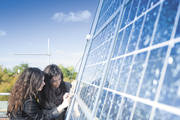Nanomaterial inspired by nature paves way for greener energy
Release Date 20 December 2012

A new nanomaterial, which finds its inspiration in nature, will provide the potential for more efficient and greener vehicles, rechargeable batteries and solar cells.
Researchers at the University of Reading have patented a new method of making electrode coatings with a thousand-fold increase in surface area compared with a flat electrode. This larger surface means that conversion of fuel or sunlight into electricity can take place in a smaller, more compact cell, making the cells cheaper to produce. The chemical reaction to create the energy also takes place at room temperature allowing the cells to be fitted to cheap materials such as plastic for the first time.
Based on structures found in the natural world which occur within mitochondria and chloroplasts, nature's own "fuel cells" and "solar cells", the new nanostructure is formed of a network of tiny wires, millionths of a millimetre in size, and is created by growing the metal in a template made from a plant molecule. This creates a structure known as a "bicontinuous cubic phase".
Dr Adam Squires, of the Department of Chemistry at the University of Reading, said: "Making electrodes more efficient lies at the heart of making our energy production more sustainable. This novel electrode coating technique has applications for fuel cells¹ in the newest generation of hybrid cars, photovoltaic cells, rechargeable batteries or battery production for a wide range of green technologies."
The process works in water using a technique known as electrochemical deposition, similar to silver plating a coin, and can be applied to any conducting electrode, creating a low cost, mass manufacture component. The unique 3D nanostructure enables much better conductivity and is the ideal shape for a high area electrode to create a more effective energy supply. Potentially, the technique could lead to energy storage devices with much greater capacity than traditional cells.
Dr Squires continued: "The method of production is chemically mild, environmentally friendly and crucially takes place at room temperature, which means that electrodes could be fitted to a range of other materials. It will allow, for example, photovoltaic cells to be located on a plastic base rather than the currently used metal or glass, which will make renewable energy technologies more flexible, lightweight and cost effective."
The work was carried out by Dr Samina Akbar when she was a PhD student at the University of Reading, in a joint project between the research groups of Dr Adam Squires and Dr Joanne Elliott. The findings are published in the journal Advanced Materials this week.